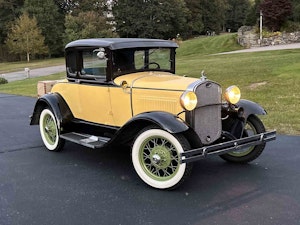Media | Articles
The reason my ’49 Buick is still going strong? Pride in craftsmanship
I stared at my brand-new string trimmer lying dead in the grass. After receiving a full charge, it had lived a useful life of roughly seven minutes before it stopped answering to the trigger control. Swearing loudly enough to make my neighbor’s dogs bark, I picked it up and stuffed it back in the box from which I had only just removed it and then dragged it back to the Home Depot from which I had only just purchased it. My previous trimmer, a low-priced job, was such a flimsy, penny-pinched design that it wasn’t even worth repairing when it died. So I bought a sleek $179 yellow and black model, the most expensive one in the store. It lasted seven minutes, probably because of a faulty battery pack, and the guy in customer service told me to leave it and just go take a whole new trimmer.
It’s galling because I’ve had my share of encounters with lousy consumer goods, from a lemon built-in fridge to a new inkjet printer that expelled exactly 12 sheets before breaking. Twelve—I counted them. Does anyone bother to make quality anymore? It’s a question I ask myself every time I’m facing a purchase, praying to the divine to guide my hand to one that won’t have to be immediately returned.
I can’t help thinking of my 1949 Buick Special. At 70 years old, it is still rolling its odometer, an exquisite work of industrial art by today’s plasticized, slap-dash standards. Nearly every component of that Buick is cast, forged, or stamped metal, put through a machining mill and held together by proper bolts, welds, or screws. Seven decades and zero restorations later (OK, I’ve done some engine work, but only to the top end), mechanisms such as the window winders still operate with the slippery precision of a glockenspiel.
When its original owner, one Odessa Hensley of Franklin, Indiana, bought my Buick new on December 4, 1948, it was the cheapest model then cranked out by GM’s sprawling plant in Flint. But if you made a car today the way this Buick was made, with its hand-leaded body seams and twin, steel-sphered horns, which emit a mellifluous blast that would clear a path through New York Harbor, it would command the price of a Bentley. Actually, probably more, since even a new Bentley has plastic. Heck, you can’t even put new reproduction ’49 Buick parts into a ’49 Buick with absolute certainty since, as we all know, the classic-car supply chain is thoroughly contaminated with chintzy foreign-made crapola.
After China opened up its economy in the 1980s and became the world’s sweatshop, we all became addicted to inexpensive goods. Some of it wasn’t bad, especially considering how astonishingly cheap it was. But as costs went up in China and our expectation for bargain prices solidified into concrete, companies had to take action to maintain a profit margin. Nowadays, they chisel every last ducat out of a design before punting it to overseas factories to slam together as fast as possible. Failure rates are a managed percentage, just another line on the balance sheet to be offset by the huge volumes enabled by vast distribution webs of big-box and online retailers. Sell enough $49 string trimmers on Amazon, and it doesn’t really matter if 7.2 percent of them are completely unusable garbage out of the box and the rest only last a season or two. We throw them away and go back for another. When they murdered pride in craftsmanship, pride in ownership died along with it.
Marketplace
Buy and sell classics with confidence
If you’re the type who always goes for the cheap thing, you’re perpetuating our throw-it-away culture. You know from owning old cars that it wasn’t always this way. Sure, cars once needed valve jobs and other maintenance we don’t have to do today, but don’t confuse a lack of technology with a lack of intent. They did the best they could with the know-how they had to deliver a durable product at affordable prices. And they were selling to a hardened, self-reliant generation that managed to get by on far less stuff than we have today. Partly because they never threw anything away.
The article first appeared in Hagerty Drivers Club magazine. Click here to subscribe to our magazine and join the club.










